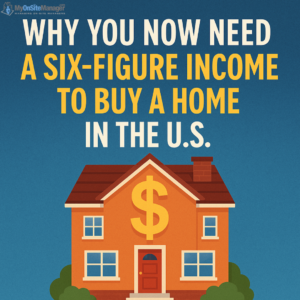The American Dream of homeownership is slipping farther out of reach—and fast. According to new data from Bankrate and industry experts, the income required to afford a median-priced home in the U.S. now exceeds $117,000 per year. For millions of Americans, especially first-time buyers, the barriers to buying a home in 2025 are higher than ever before.
Source: WPDE – Homeownership in the U.S. now requires a six-figure income
Mortgage Rates Have Skyrocketed
Let’s start with the numbers. In 2021, mortgage rates hovered around 3%. Fast-forward to today, and we’re looking at rates above 7%, with no guarantee they’ll drop soon. That spike has doubled monthly payments for many prospective buyers—even if home prices had remained flat (which they haven’t).
Higher interest rates mean you can afford less house for more money. That $1,600 monthly payment at 3% interest now costs over $2,600 at 7% interest. For most Americans, this shift alone is enough to disqualify them from mortgage approval.
Home Prices Aren’t Coming Down
Despite some cooling in hot markets, the national median home price is still over $418,000. That means a typical buyer now needs a six-figure salary—$117,100 or more—just to qualify for financing in today’s market.
In high-cost metro areas like San Francisco, San Jose, or Seattle, the required income jumps to $200,000–$250,000 or more.
Why? Two big reasons:
-
Tight supply: Existing homeowners with low mortgage rates are staying put, so fewer homes are available.
-
Slow new construction: Builders are facing increased costs and delays.
Tariffs & Construction Costs Add Fuel to the Fire
It’s not just resale homes. New builds are getting more expensive too.
Tariffs on materials like steel, lumber, glass, and even appliances have made it more costly to build new homes. The National Association of Home Builders estimates that tariffs alone could add $8,000 to $12,000 per home, and in some cases even more.
As a result, builders are either passing these costs on to buyers—or slowing construction altogether, which contributes to the broader inventory shortage.
Fewer First-Time Buyers
In the early 2010s, first-time buyers made up around 45-50% of all homebuyers. Today? That number has dropped to just 24%, according to recent industry data.
Many of these potential buyers are now renting longer, living with parents, or delaying family planning and other life milestones. The impact ripples across the economy: lower household formation, lower consumer spending, and less upward mobility.
The New Math of Homeownership
So what does it take to buy in 2025?
Here’s a simple breakdown based on current averages:
| Scenario | 2021 | 2025 |
|---|---|---|
| Median U.S. Home Price | $350,000 | $418,000+ |
| Mortgage Rate | 3.2% | 7.1% |
| Down Payment (20%) | $70,000 | $83,600 |
| Monthly Payment (P&I only) | ~$1,200 | ~$2,650+ |
| Required Income | ~$60,000 | $117,100 |
Estimates based on Bankrate and Freddie Mac averages
What Can Buyers Do?
The outlook may be tough—but it’s not hopeless. Here are some strategic options:
-
Consider townhomes or condos. They typically cost 15–30% less than single-family homes.
-
Expand your location search. Areas just outside urban cores may offer better value and inventory.
-
Build your credit and savings. Strong credit scores can help secure better interest rates.
-
Use first-time buyer programs. Many states still offer down payment assistance or FHA options.
-
Partner with family. Co-borrowing with a parent or spouse is increasingly common—often called a “nepo-buying” trend.
Is Renting the Smarter Choice in 2025?
With homeownership costs surging, renting may be the more practical and flexible option—especially for younger professionals or those in transitional phases of life. Renting allows people to:
-
Stay mobile
-
Avoid costly repairs and maintenance
-
Build savings for a future purchase when rates drop
If you’re managing rentals, this trend could be an opportunity. More long-term renters means stable demand—but also rising expectations for quality, amenities, and management.
Final Thoughts
Homeownership has long been a cornerstone of the American Dream—but in 2025, it’s increasingly a luxury item. While incomes have grown modestly, housing costs and mortgage rates have outpaced them dramatically.
Unless major policy changes occur—such as aggressive homebuilding incentives, interest rate relief, or reduced tariffs—the six-figure income threshold may become the norm, not the exception.
Original Article Source: Homeownership in the U.S. now requires a six‑figure income – WPDE

